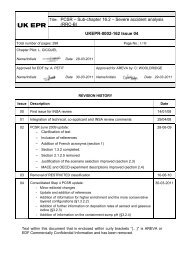Level 3 PSA - EDF Hinkley Point
Level 3 PSA - EDF Hinkley Point
Level 3 PSA - EDF Hinkley Point
Create successful ePaper yourself
Turn your PDF publications into a flip-book with our unique Google optimized e-Paper software.
HPC-NNBOSL-U0-000-RES-000028 Version 1.0<br />
<strong>Level</strong> 3 <strong>PSA</strong><br />
NOT PROTECTIVELY MARKED<br />
The annualised probability of death of the most exposed individual due to accidents is<br />
then given by:<br />
where<br />
<br />
F Min[1.0,<br />
510<br />
i<br />
5<br />
D ]<br />
i<br />
F i<br />
D i<br />
= the frequency of an individual receiving an effective dose in dose band i<br />
= magnitude of the dose in mSv<br />
and the summation is taken over the five dose bands. To give a conservative result D i is<br />
taken as the effective dose at the upper limit of the dose band except for dose band 5<br />
where a unit probability of individual death is assumed 1 .<br />
Applying the above equation, with the data in Table 17, results in a risk of individual<br />
death of 2.8x10 -7 /ry, which is considered pessimistic.<br />
If the risk from a single unit is doubled [AS-001] to take into account HPC is intended to<br />
be a twin unit site then this risk becomes 5.6x10 -7 per year.<br />
Both the risk from an individual unit site and the risk from a twin reactor site meet the<br />
target set by Safety Design Objective SDO-6.<br />
4 ASSESSMENT OF SOCIETAL RISK<br />
One of the goals of the EPR design philosophy is to reduce the frequency of releasing<br />
substantial amounts of radioactivity into the off-site environment, compared to the<br />
current generation of PWRs. Consideration of the frequency of accidents leading to such<br />
large releases is an appropriate way to assess societal risk. SDO-8, set out in the<br />
NSDAPs [Ref. 1], sets a target of 1.0E-07 per year for the frequency of exceeding 100<br />
immediate or eventual fatalities in members of the public.<br />
SDO-8: The total predicted frequency of on-site accidents resulting in more than<br />
100 fatalities (either immediate or delayed) of members of the public will be below<br />
1x10-7 per year and/or demonstrated as ALARP<br />
The <strong>Level</strong> 3 <strong>PSA</strong> identifies those accident sequences with the potential to result in<br />
environmental source terms sufficient to cause 100 or more fatalities in the wider<br />
population, both immediate and eventual, taking appropriate responses into account.<br />
The likelihood of early radiation induced fatalities is very low. The majority of the off-site<br />
fatalities are ‘statistical deaths’ arising from integrating low doses over very large<br />
populations over a significant period of time.<br />
These calculations are performed with a probabilistic accident consequence assessment<br />
system called PC COSYMA. This model has been updated for use in the UK by the<br />
Health Protection Agency (HPA). The software calculates the dispersion and deposition<br />
of radioactive material for a given source term using a segmented Gaussian Plume<br />
dispersion model. It produces a probability distribution of results based upon a sample of<br />
historical meteorological conditions. The detailed methodology is set out in [Ref. 17] and<br />
the PC COSYMA calculations and analysis are set out in [Ref. 18].<br />
1 It should be noted that this is slightly different from the approach taken in the Worker Risk Assessment<br />
presented in section 5 where the mid-point of the dose band is used in the calculation to obtain a less<br />
conservative result.<br />
UNCONTROLLED WHEN PRINTED<br />
NOT PROTECTIVELY MARKED<br />
Page 16 of 60














![6.3 - Safety Injection System (RIS [SIS]) - EDF Hinkley Point](https://img.yumpu.com/42739985/1/184x260/63-safety-injection-system-ris-sis-edf-hinkley-point.jpg?quality=85)


